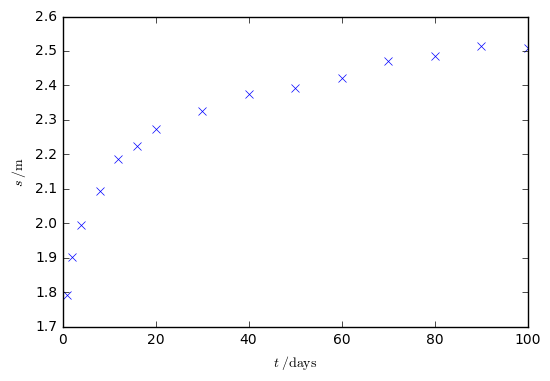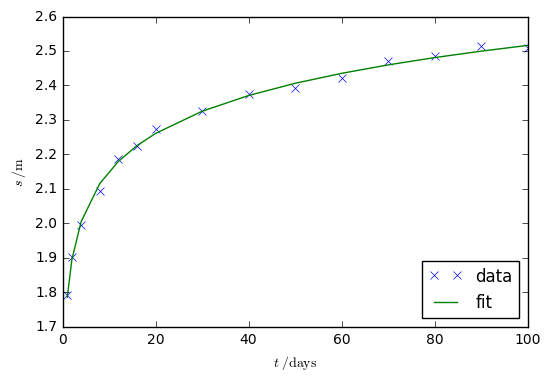Linear and non-linear fitting of the Theis equation
Posted on 02 December 2016
The Theis equation
This post is also available as a Jupyter Notebook.
The drawdown or change in hydraulic head, $s$ (a measure of the water pressure above some geodetic datum) a distance $r$ from a well at time $t$ from which water is being pumped at a constant rate, $Q$, can be modelled using the Theis equation, $$ s(r, t) = H_0 - H(r,t) = \frac{Q}{4\pi T}W(u), \quad \mathrm{where}\quad u = \frac{r^2S}{4Tt}. $$ Here $H_0$ is the hydraulic head in the absence of the well, $S$ is the aquifer storage coefficient (volume of water released per unit decrease in $H$ per unit area) and $T$ is the transmissivity (a measure of how much water is transported horizontally per unit time). The Well Function, $W(u)$ is simply the exponential integral, $E_1(u).$
In practice, it is often more convenient to use an approximation to the exponential integral: $W(u) \approx -\gamma - \ln u$ where $\gamma=0.577215664\cdots$ is the Euler-Mascheroni constant. This results in an expression for $s(r,t)$ known as the Jacob equation: $$ s(r,t) = -\frac{Q}{4\pi T}\left(\gamma + \ln u \right). $$
The following code uses scipy.special.exp1 to calculate the full Theis equation, returning $s(r,t)$ for parameters $Q$, $S$ and $T$.
import numpy as np
import matplotlib.pyplot as plt
from scipy.special import exp1
def calc_u(r, S, T, t):
"""Calculate and return the dimensionless time parameter, u."""
return r**2 * S / 4 / T / t
def theis_drawdown(t, S, T, Q, r):
"""Calculate and return the drawdown s(r,t) for parameters S, T.
This version uses the Theis equation, s(r,t) = Q * W(u) / (4.pi.T),
where W(u) is the Well function for u = Sr^2 / (4Tt).
S is the aquifer storage coefficient,
T is the transmissivity (m2/day),
r is the distance from the well (m), and
Q is the pumping rate (m3/day).
"""
u = calc_u(r, S, T, t)
s_theis = Q/4/np.pi/T * exp1(u)
return s_theis
Let's simulate a curve for $s(t)$ for a fixed distance from the well, $r=25\;\mathrm{m}$, and pumping rate $Q = 2000\;\mathrm{m^3/day}$ for a well with parameters $S = 0.0003$ and $T = 1000\;\mathrm{m^2/day}$. We'll add a bit of synthetic normally-distributed noise.
Q = 2000 # Pumping rate from well (m3/day)
r = 10 # Distance from well (m)
# Time grid, days.
t = np.array([1, 2, 4, 8, 12, 16, 20, 30, 40, 50, 60, 70, 80, 90, 100])
# Calculate some synthetic data to fit.
S, T = 0.0003, 1000
s = theis_drawdown(t, S, T, Q, r)
# Add some noise.
noise_sd = 4.e-3
s += s * noise_sd * np.random.randn(s.shape[0])
# Plot the data
plt.plot(t, s, 'x')
plt.xlabel(r'$t\;/\mathrm{days}$')
plt.ylabel(r'$s\;/\mathrm{m}$')
plt.show()

Fitting the data
Linear least squares fit
It is often the case that $s$ can be measured over time at a fixed distance from the well, $r$, for a known pumping rate $Q$, and it is required that the parameters $S$ and $T$ be found. The Theis equation is clearly non-linear in $t$, but the Jacob approximation to it can produce a straight-line plot, since: $$ s(r,t) = -\frac{Q}{4\pi T}\left[\gamma + \ln\left(\frac{r^2S}{4T}\right)\right] + \frac{Q}{4\pi T}\ln t, $$ So a plot of $s$ against $\ln t$ is a straight line with intercept and gradient $$ c = -\frac{Q}{4\pi T}\left[\gamma + \ln\left(\frac{r^2S}{4T}\right)\right] \quad \mathrm{and}\quad m = \frac{Q}{4\pi T} $$ whence, $$ T = \frac{Q}{4\pi m}, \quad S = \frac{4T}{r^2}\exp\left[-\left(\frac{c}{m}+\gamma\right)\right] $$
The most straightforward approach is to use NumPy's polyfit routine to fit a first-order polynomial (i.e. a straight line) through the data points $(s_i, \ln t_i)$:
# fit s, ln(t)
lnt = np.log(t)
coeffs = np.polyfit(np.log(t), s, 1)
# plot the data and the fitted straight line
plt.plot(lnt, s, ls='', marker='o')
fit_line = np.poly1d(coeffs)(lnt)
plt.plot(lnt, fit_line)
plt.show()
# Output the fitted coefficients and report the rms residual
print('m = {}, c = {}'.format(*coeffs))
rms_residual = np.sqrt(np.sum((fit_line - s)**2))
print('rms residual =', rms_residual)

m = 0.15873714463615268, c = 1.785086631832805
rms residual = 0.0402157944671
The parameters $S$ and $T$ which best fit the data are found to be as follows, and seem to agree well with the values used to create the simulated data set.
m, c = coeffs
def get_S_and_T(m, c):
Tfit = Q / 4 / np.pi / m
Sfit = 4 * Tfit / r**2 * np.exp(-(c/m + np.euler_gamma))
return Sfit, Tfit
print('S = {}, T = {} m2/day'.format(*get_S_and_T(m,c)))
Output:
S = 0.00029419771863093883, T = 1002.6320144330448 m2/day
The same analysis can be performed using numpy.linalg.lstsq which returns the sum of the square residuals along with other information about the fit:
A = np.vstack((lnt, np.ones_like(t))).T
x, sq_resid, rank, sing_vals = np.linalg.lstsq(A, s)
m, c = x
print('S = {}, T = {} m2/day'.format(*get_S_and_T(m,c)))
print('rms residual =', np.sqrt(sq_resid[0]))
Output:
S = 0.00029419771863094463, T = 1002.6320144330432 m2/day
rms residual = 0.0402157944671
Nonlinear least squares fit
The full Theis equation can only be fit with a nonlinear routine such as scipy.optimize.curve_fit or scipy.optimize import leastsq. curve_fit can fit a function directly; it calls leastsq which minimizes the sum of squares of a set of equations: in this context, the residuals between the observed data and modelled $s(t)$.
A. curve_fit
curve_fit does not need an initial guess for the fit parameters (it sets them equal to 1 if none is provided, which may or may not be appropriate depending on the function). The function to be fit must take the independent variable as its first argument (here, $t$) and the parameters to be fit as the remaining arguments. Since we don't want to fit $Q$ and $r$, we'll define a wrapper function to pick them up in global scope and send them to theis_drawdown which requires them.
from scipy.optimize import curve_fit
def theis_func(t, S, T):
return theis_drawdown(t, S, T, Q, r)
popt, pcov = curve_fit(theis_func, t, s)
Sfit, Tfit = popt
print('S = {}, T = {} m2/day'.format(Sfit, Tfit))
theis_fit = theis_drawdown(t, Sfit, Tfit, Q, r)
rms_resid = np.sqrt(np.sum((s - theis_fit)**2))
print('rms residual =', rms_resid)
Output:
S = 0.0002942031272530988, T = 1002.6307076502651 m2/day
rms residual = 0.040215620786
We can also plot the fit:
plt.plot(t, s, 'x', label='data')
plt.plot(t, theis_fit, label='fit')
plt.xlabel(r'$t\;/\mathrm{days}$')
plt.ylabel(r'$s\;/\mathrm{m}$')
plt.legend(loc=4)
plt.show()

B. leastsq
leastsq requires an initial guess for the fit parameters but allows additional arguments (beyond the fit parameters) to be passed to the objective function. However, it requires a function to calculate the residuals: the difference between the "observed" and "modelled" data points:
from scipy.optimize import leastsq
def theis_resid(p, t, s, Q, r):
"""Calculate the residual between observed and calculated drawdown s(t).
This version uses the exact Theis equation.
The parameters S, T are packed into the tuple p.
"""
S, T = p
return s - theis_drawdown(t, S, T, Q, r)
Both leastsq and curve_fit can be provided with the Jacobian: a vector of the first derivatives of the model function with respect to each of the fit parameters. In the case of the Theis function, these can be calculated analytically:
$$
\frac{\mathrm{d}s(r,t)}{\mathrm{d}S} = -\frac{Q}{4\pi T S}e^{-u}
\quad \mathrm{and} \quad
\frac{\mathrm{d}s(r,t)}{\mathrm{d}T} = \frac{Q}{4\pi T^2}\left[-W(u) + e^{-u}\right]
$$
def theis_Dfun(p, t, s, Q, r):
"""Calculate and return ds/dS and ds/dT for the Theis equation.
The parameters S, T are packed into the tuple p.
"""
S, T = p
u = calc_u(r, S, T, t)
dsdS = -Q / 4 / np.pi / T / S * np.exp(-u)
dsdT = Q / 4 / np.pi / T**2 * (-exp1(u) + np.exp(-u))
return np.array((-dsdS, -dsdT)).T
# Initial guesses for the fit parameters
p0 = 0.01, 1500
popt, flag = leastsq(theis_resid, p0, Dfun=theis_Dfun, args=(t, s, Q, r))
Sfit, Tfit = popt
print('S = {}, T = {} m2/day'.format(Sfit, Tfit))
theis_fit = theis_drawdown(t, Sfit, Tfit, Q, r)
rms_resid = np.sqrt(np.sum((s - theis_fit)**2))
print('rms residual =', rms_resid)
Output:
S = 0.00029420317360281554, T = 1002.6306958749764 m2/day
rms residual = 0.040215620786